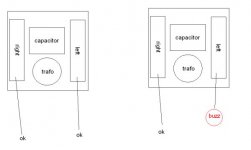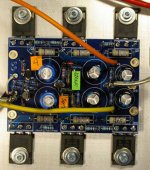José Humberto said:...what does sound with the Nichicon?
Do you hear differences?
Hi Jose,
Differences are difficult to explain.
Before:
Ambient scene was larger, easier to observe, sound was sharper and more aggressive in the treble, especially at >50C, like conventional capacitors added more grain at higher temperatures. Altogether – I was tired after one hour of listening.
Now:
C1/C2 = 220uF/50V “Bi-polarized Nichicon MUSE ES (green)” plus added in parallel 47nF/100V “VISHAY MKP”
C3/C4 = 220uF/50V “Nichicon MUSE KZ”
There is more air but at the same time ambient scene is not so large as before, I do not understand why. Now the sound is clearer. Less grain. Piano sounds much better, almost perfect. Altogether – listening is more comfortable.
Someday I hope to try 100uF “Black Gate N”, maybe with added in parallel 0.47uF “Black Gate NX”.
Best Regards,
a.
Someday I hope to try 100uF “Black Gate N”, maybe with added in parallel 0.47uF “Black Gate NX”.
I´m glad the change is good.
¡Black Gate! Uff
I have done the sum 223,2$
I´m thinking in Mundorf. Please don´t add it. Hehe.
Best Regards
Jose
Nichicons need to "run-in" for quite a few hours - at least 24 to 48, before they start to sound good - MKPs taken longer.
If you are patient with them, you should get a very clean sound overall with a heavier, more solid base.
Might find the 47nF may (note: MAY) benefit from a 0.1ohm in series.
If you are patient with them, you should get a very clean sound overall with a heavier, more solid base.
Might find the 47nF may (note: MAY) benefit from a 0.1ohm in series.
Hi
I'm also thinking about upgrading c1/c2 and replacing my panasonic fc with blackgate fk or something similar. I'm actually quite curious what kind of caps other people are using.
cheers,
c.
I'm also thinking about upgrading c1/c2 and replacing my panasonic fc with blackgate fk or something similar. I'm actually quite curious what kind of caps other people are using.
cheers,
c.
I'm actually using Elna Cerafines... they were my first choice so i'm not able to make comparisons among other caps. All i can say is F4 sounds just marvelous to my ears 🙂
jameshillj said:Nichicons need to "run-in" for quite a few hours - at least 24 to 48, before they start to sound good - MKPs taken longer.
If you are patient with them, you should get a very clean sound overall with a heavier, more solid base.
Might find the 47nF may (note: MAY) benefit from a 0.1ohm in series.
JH,
Thank you very much for interesting advices.
Today I listened with pleasure a cappella choir singing ancient music. I discovered delicate natural hisses. And a choir breathe in at Vangelis 1492. Very nice impressions. When capacitors mature maybe it will start to disturb me someday, or not, I will know. My wrong hearing depends on if I am tired, a little bit drunk, or just have a cold...
Best Regards,
a
Helloo there!
I have built a pair of F4's and they work just fine, but i have a little problem with one of the chanels. It has a very little buzz. It is so little that it is bearly hearable with the ear next to the speaker - but it is there and it is annoying. The othere 3 chanels are dead quiet.
Anyoane any ideea of what shoud be the problem????
PS: I do not have ground loops and all of the other chanels work in the same conditions.
I have built a pair of F4's and they work just fine, but i have a little problem with one of the chanels. It has a very little buzz. It is so little that it is bearly hearable with the ear next to the speaker - but it is there and it is annoying. The othere 3 chanels are dead quiet.
Anyoane any ideea of what shoud be the problem????
PS: I do not have ground loops and all of the other chanels work in the same conditions.
Can you take a picture of the amp? Perhaps the mains is running close to your input or you have a problem with grounding.
ahegyes said:Here is a drawing of the 2 f4's and the buzz...
Hi...you can try the following:
1. Check the resistors for correct values. If you have a faulty ground resistor (as I had with my A30) you will have exactly this problem.
2. Isolate the humming channel, so it is the only active channel. trace with a scope where the humm is comming from. Is is 50 or 100Hz? 50Hz could indicate humm pickup from mains; 100Hz pickup after rectification. 100Hz could indicate a bad cap or high bias current.
3. Compare the DC voltages on every node of the amp and compare them with the other channels. Try to find the origine of each deviation.
4. Use cold spray / solder iron to heat/chill the Jfets Junction problems can cause this as well.
5. Inspect the PCB for parasitic traces of solder.
6. Only use the amp with teh humming channel. Leave the other disconnected. Is the amp still humming? if not...are you sure about your grounding?
I hope this helps. This can be quite hard to find...
ahegyes said:Helloo there!
I have built a pair of F4's and they work just fine, but i have a little problem with one of the chanels. It has a very little buzz. It is so little that it is bearly hearable with the ear next to the speaker - but it is there and it is annoying. The othere 3 chanels are dead quiet.
Anyoane any ideea of what shoud be the problem????
PS: I do not have ground loops and all of the other chanels work in the same conditions.
- try to move cables (left, up, right, down) connected to this channel
- move transformer or the buzzing board - maybe the distance is to short
I've read the earlier part of the thread where early builders had problems trying to dial in enough bias current when adjusting P1. Some circumvented the problem by changing R9 to 6.8k instead of the original 10k.
But I wondered if it is because the earliest schematic had R8 at 22.1k instead of the latest schematic which had R8 at 27.4k.
So did any of the recent builders using the latest schematic had issues dialing in the bias current with R9 at 10k?
thanks
her shann
But I wondered if it is because the earliest schematic had R8 at 22.1k instead of the latest schematic which had R8 at 27.4k.
So did any of the recent builders using the latest schematic had issues dialing in the bias current with R9 at 10k?
thanks
her shann
I'm using Peter's pcbs and the latest schematics. I mistakenly fired it up with P1 running full tilt--there's was ample bias current. Seems to me I had a 400mV reading across the 0.47 ohm resistors.
carpenter said:I'm using Peter's pcbs and the latest schematics. I mistakenly fired it up with P1 running full tilt--there's was ample bias current. Seems to me I had a 400mV reading across the 0.47 ohm resistors.
Thanks for the info - am using Peter's PCB too.
Will use 10k for R9 then.
her shann
Andrzej Sochon said:Her Shann,
Set every P1 and P2 in the middle.
Set every P1 and P2 in the middle before you attach supply voltages for the very first time. Then begin to turn P1 to adjust 130 mV on one of the 0.47R, while all is cold.
Regards,
a
jameshillj said:Nichicons need to "run-in" for quite a few hours - at least 24 to 48, before they start to sound good - MKPs taken longer.
If you are patient with them, you should get a very clean sound overall with a heavier, more solid base....
Hello JH,
I try to be patient, not easy. I see I have some problems with my ears,
a kind of slight infection. Normally I do not hear the differences but while listening my f4 I discover sometime better perception of trebles at the left, sometime at the right side. From few days I plug my ears with cotton wool when I am outdoor, it helps me to keep acoustic symmetry of audio perception later, at home. I am sensitive for a cold weather.
I also observe not so deep ambient acoustic scene as before Nichicons with MKP Vishay caps. Sound is perfectly clear now, maybe to much highest frequencies, maybe I will detach MKPs later.
Did you have similar phenomena?
Regards,
a.


- Home
- Amplifiers
- Pass Labs
- F4 power amplifier

